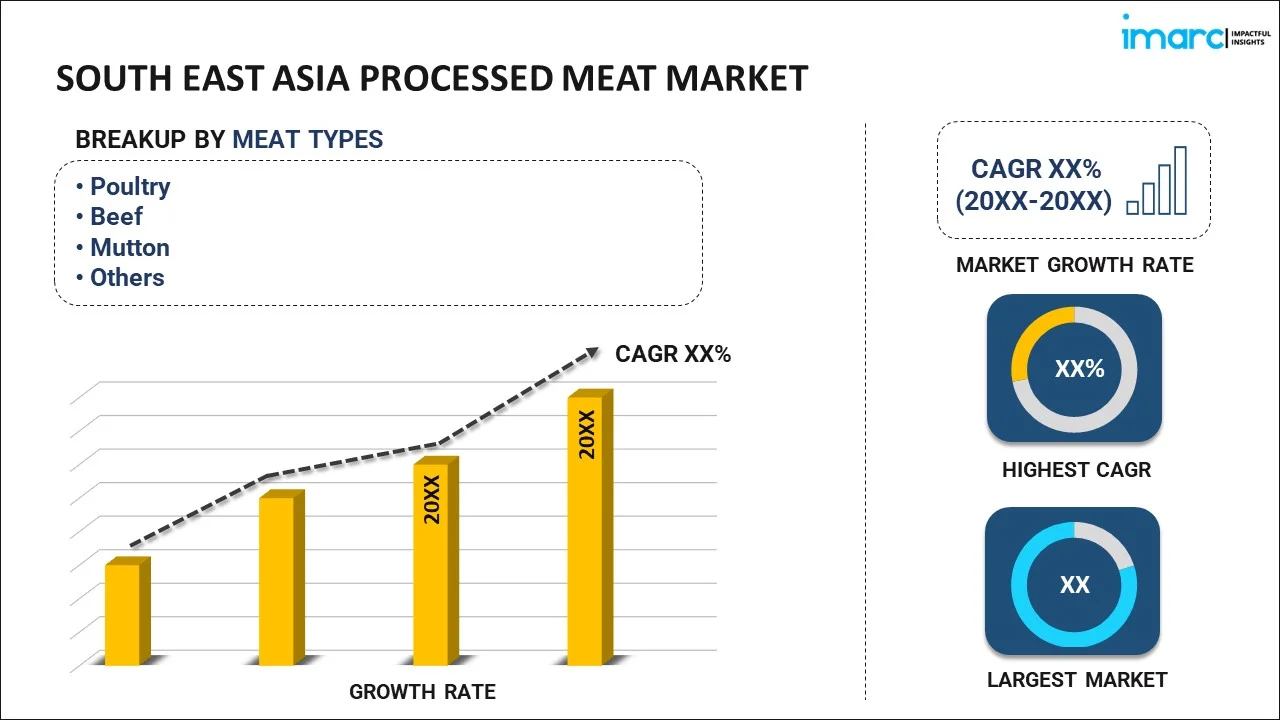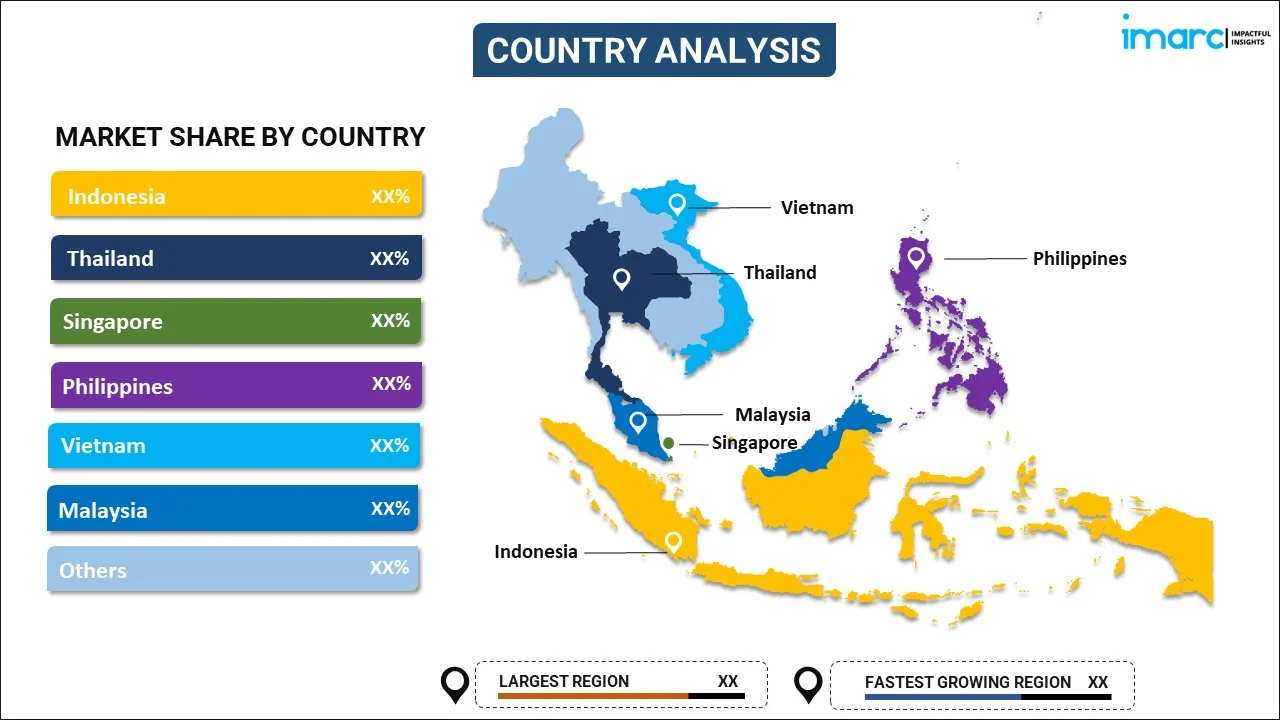
South East Asia Processed Meat Market Report by Meat Type (Poultry, Beef, Mutton, Pork, and Others), Product Type (Fresh-Processed Meat, Raw Fermented Meat, Raw-Cooked Meat, Pre-Cooked Meat, Cured Meat, Dried Meat, and Others), Processing Type (Chilled, Frozen, Canned), Distribution (Institutional Sales (HoReCa), Retail Sales), and Country 2025-2033
Market Overview:
South East Asia processed meat market size is projected to exhibit a growth rate (CAGR) of 5.30% during 2025-2033. The growing urbanization in South East Asia, expanding middle class with higher disposable income, increasing need for quick and convenient food options, booming tourism industry, and growing adoption of processed meat by health-conscious consumers represent some of the key factors driving the market.
|
Report Attribute
|
Key Statistics
|
|---|---|
|
Base Year
|
2024 |
|
Forecast Years
|
2025-2033
|
|
Historical Years
|
2019-2024
|
| Market Growth Rate (2025-2033) | 5.30% |
Processed meat refers to meat that has been altered through various methods, such as salting, curing, fermentation, smoking, or other processes, to enhance flavor or improve preservation. It includes sausages, bacon, ham, salami, and jerky. Processed meat exhibits several properties, such as extended shelf life, improved taste, and convenience. Its manufacturing process involves the addition of preservatives, flavorings, and other additives to prevent spoilage and bacterial growth. Processed meat finds extensive applications in ready-to-eat (RTE) meals, fast-food items, traditional cuisines, snacks, party foods, camping essentials, and emergency food supplies. It offers convenience, ease of preparation, variety in flavors, suitability for different dietary preferences, and role in cultural and traditional dishes. Additionally, processed meat is known for its consistent quality, year-round availability, portion control, and compatibility with a variety of dishes.
South East Asia Processed Meat Market Trends:
The growing urbanization in South East Asia, facilitating the demand for convenient and quick meal options like processed meats, is propelling the market growth. Additionally, the expanding middle class with higher disposable income, which is more inclined to experiment with diverse food options, including processed meats, is supporting the market growth. Furthermore, the introduction and acceptance of diverse cuisines in South East Asia, leading to an increased demand for various types of processed meats, is fueling the market growth. In addition, the booming tourism industry, leading to a higher demand for processed meats in hotels, resorts, and restaurants, is catalyzing the market growth. Apart from this, the growing adoption of processed meat by health-conscious consumers into their diets, is bolstering the market growth. Moreover, the introduction of modern food processing technologies, which have improved the quality and safety of processed meats, making them more appealing to consumers, is positively influencing the market growth. Along with this, the rising number of online shopping and food delivery services, which have made accessing processed meats easier for consumers, is strengthening the market growth. Additionally, the development of processed meats with longer shelf life, which caters well to the modern consumer’s need for storage-friendly food options, is stimulating the market growth. Furthermore, the rising influence of Western eating habits, leading to increased consumption of products like sausages and bacon, is acting as another growth-inducing factor. Besides this, continuous innovation in flavors and product types to attract a broader customer base is accelerating the market growth. In addition to this, the shifting trend towards high-protein diets, which has boosted the consumption of processed meats, is fostering the market growth.
South East Asia Processed Meat Market Segmentation:
IMARC Group provides an analysis of the key trends in each segment of the market, along with forecasts at the regional and country levels for 2025-2033. Our report has categorized the market based on meat type, product type, processing type, and distribution.
Meat Type Insights:

- Poultry
- Beef
- Mutton
- Pork
- Others
The report has provided a detailed breakup and analysis of the market based on the meat type. This includes poultry, beef, mutton, pork, and others.
Product Type Insights:
- Fresh-Processed Meat
- Raw Fermented Meat
- Raw-Cooked Meat
- Pre-Cooked Meat
- Cured Meat
- Dried Meat
- Others
A detailed breakup and analysis of the market based on the product type have also been provided in the report. This includes fresh-processed meat, raw fermented meat, raw-cooked meat, pre-cooked meat, cured meat, dried meat, and others.
Processing Type Insights:
- Chilled
- Frozen
- Canned
The report has provided a detailed breakup and analysis of the market based on the processing type. This includes chilled, frozen, and canned.
Distribution Insights:
- Institutional Sales (HoReCa)
- Retail Sales
- Supermarkets and Hypermarkets
- Grocery Stores
- Specialty Retailers
- Online Stores
- Others
A detailed breakup and analysis of the market based on the distribution have also been provided in the report. This includes institutional sales (HoReCa) and retail sales (supermarkets and hypermarkets, grocery stores, specialty retailers, online stores, and others).
Country Insights:

- Indonesia
- Thailand
- Singapore
- Philippines
- Vietnam
- Malaysia
- Others
The report has also provided a comprehensive analysis of all the major regional markets, which include Indonesia, Thailand, Singapore, Philippines, Vietnam, Malaysia, and Others.
Competitive Landscape:
The market research report has also provided a comprehensive analysis of the competitive landscape. Competitive analysis such as market structure, key player positioning, top winning strategies, competitive dashboard, and company evaluation quadrant has been covered in the report. Also, detailed profiles of all major companies have been provided.
South East Asia Processed Meat Market Report Coverage:
| Report Features | Details |
|---|---|
| Base Year of the Analysis | 2024 |
| Historical Period | 2019-2024 |
| Forecast Period | 2025-2033 |
| Units | US$ Million |
| Scope of the Report | Exploration of Historical and Forecast Trends, Industry Catalysts and Challenges, Segment-Wise Historical and Predictive Market Assessment:
|
| Meat Types Covered | Poultry, Beef, Mutton, Pork, Others |
| Product Types Covered | Fresh-Processed Meat, Raw Fermented Meat, Raw-Cooked Meat, Pre-Cooked Meat, Cured Meat, Dried Meat, Others |
| Processing Types Covered | Chilled, Frozen, Canned |
| Distributions Covered |
|
| Countries Covered | Indonesia, Thailand, Singapore, Philippines, Vietnam, Malaysia, Others |
| Customization Scope | 10% Free Customization |
| Report Price and Purchase Option | Single User License: US$ 3699 Five User License: US$ 4699 Corporate License: US$ 5699 |
| Post-Sale Analyst Support | 10-12 Weeks |
| Delivery Format | PDF and Excel through Email (We can also provide the editable version of the report in PPT/Word format on special request) |
Key Questions Answered in This Report:
- How has the South East Asia processed meat market performed so far and how will it perform in the coming years?
- What has been the impact of COVID-19 on the South East Asia processed meat market?
- What is the breakup of the South East Asia processed meat market on the basis of meat type?
- What is the breakup of the South East Asia processed meat market on the basis of product type?
- What is the breakup of the South East Asia processed meat market on the basis of processing type?
- What is the breakup of the South East Asia processed meat market on the basis of distribution?
- What are the various stages in the value chain of the South East Asia processed meat market?
- What are the key driving factors and challenges in the South East Asia processed meat?
- What is the structure of the South East Asia processed meat market and who are the key players?
- What is the degree of competition in the South East Asia processed meat market?
Key Benefits for Stakeholders:
- IMARC’s industry report offers a comprehensive quantitative analysis of various market segments, historical and current market trends, market forecasts, and dynamics of the South East Asia processed meat market from 2019-2033.
- The research report provides the latest information on the market drivers, challenges, and opportunities in the South East Asia processed meat market.
- Porter's five forces analysis assist stakeholders in assessing the impact of new entrants, competitive rivalry, supplier power, buyer power, and the threat of substitution. It helps stakeholders to analyze the level of competition within the South East Asia processed meat industry and its attractiveness.
- Competitive landscape allows stakeholders to understand their competitive environment and provides an insight into the current positions of key players in the market.
Need more help?
- Speak to our experienced analysts for insights on the current market scenarios.
- Include additional segments and countries to customize the report as per your requirement.
- Gain an unparalleled competitive advantage in your domain by understanding how to utilize the report and positively impacting your operations and revenue.
- For further assistance, please connect with our analysts.
 Inquire Before Buying
Inquire Before Buying
 Speak to an Analyst
Speak to an Analyst
 Request Brochure
Request Brochure
 Request Customization
Request Customization




.webp)




.webp)












